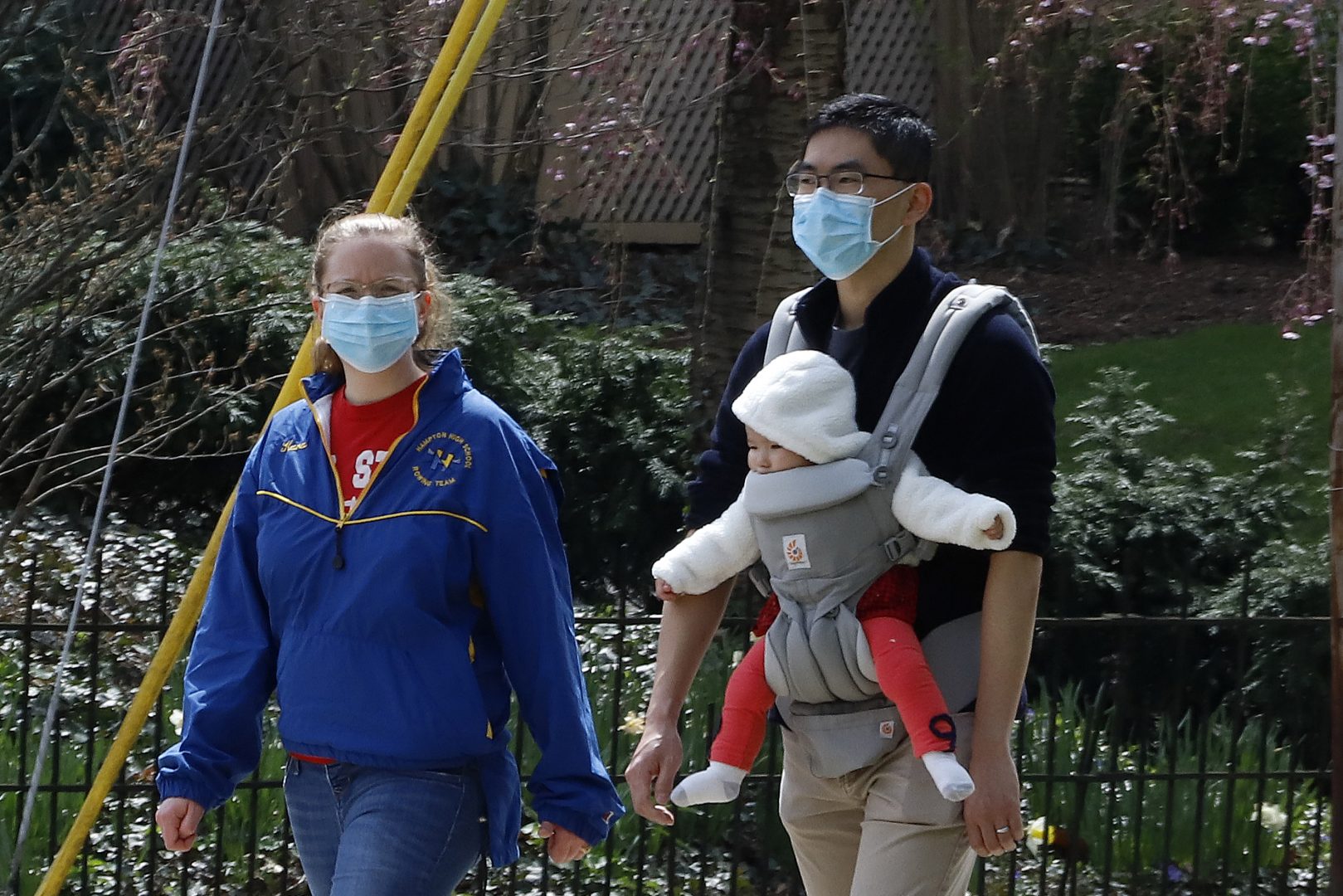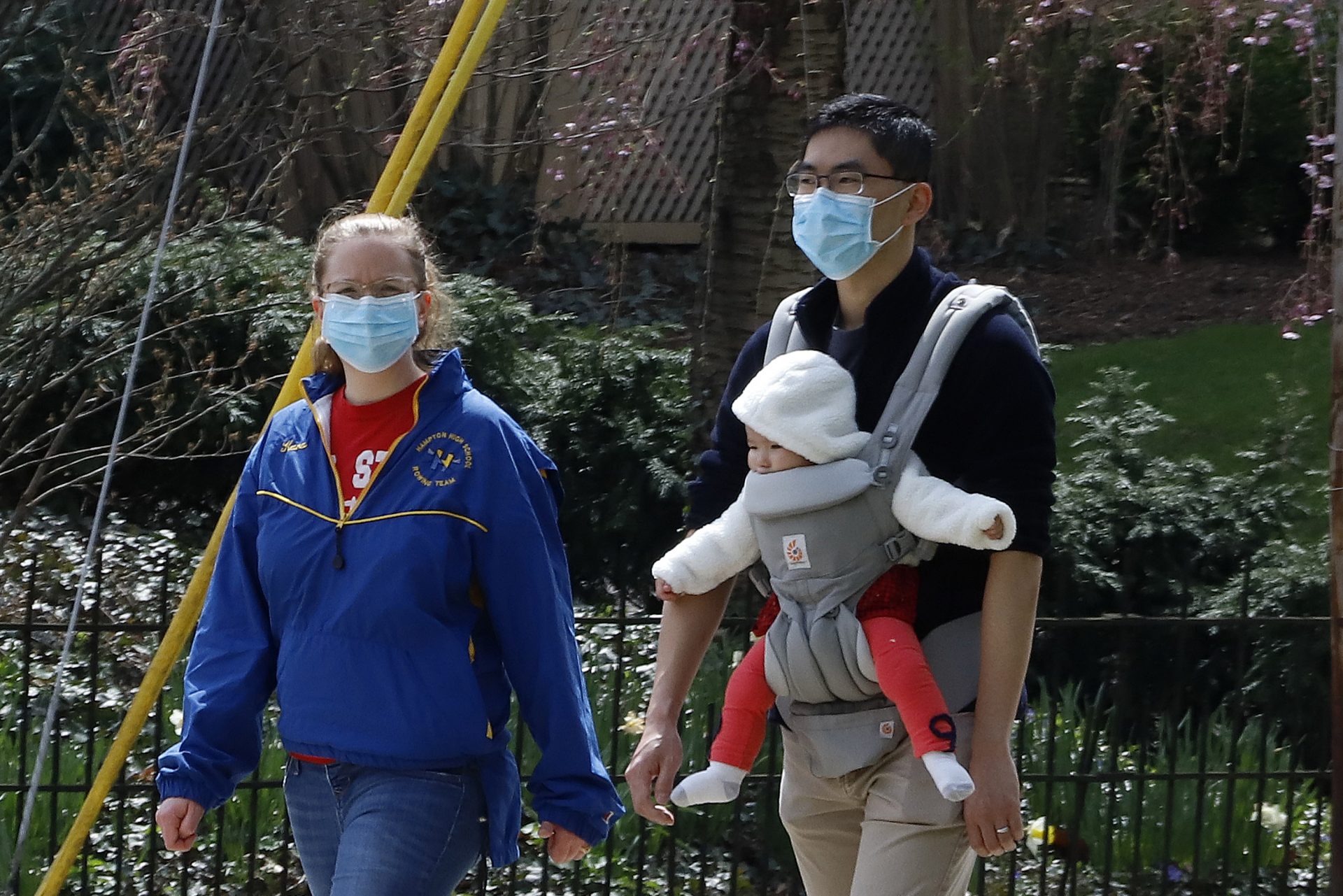
FILE PHOTO - A couple out for walk wear protective masks in Pittsburgh, Sunday, April 5, 2020.
Gene J. Puskar / AP Photo

FILE PHOTO - A couple out for walk wear protective masks in Pittsburgh, Sunday, April 5, 2020.
Gene J. Puskar / AP Photo

Gene J. Puskar / AP Photo
FILE PHOTO - A couple out for walk wear protective masks in Pittsburgh, Sunday, April 5, 2020.

Gene J. Puskar / AP Photo
A couple out for walk wear protective masks on a warm afternoon in Pittsburgh, Sunday, April 5, 2020. (Gene J. Puskar / AP Photo)
Plateau in sight?: There’s been a decrease in the number of new COVID-19 cases per day being added to Pa.’s totals over the past few days. On Monday, the state reported an increase of 1,470 cases; that’s 23 fewer cases than the day before and 127 cases lower than Saturday’s number of new cases. The decrease in cases could possibly mean we are reaching a plateau of people contracting COVID-19. But, as Pa. Health Secretary Dr. Rachel Levine said Monday, that may sound like it’s good news, but it’s much too early to tell. Related story from PublicSource: Pennsylvania’s leading COVID-19 modeler explains how life might start returning back to normal and what might not
Revised downward: It’s not just Pennsylvania that’s providing a glimmer of hope. The public health model most often cited by leaders about the potential toll of the coronavirus outbreak is always being updated as new data comes in. The good news: The epidemiological model created by University of Washington experts “is now projecting about 82,000 deaths through early August, down from an earlier estimate of 93,500. And while shortages of hospital and ICU beds will continue to be acute in hot spots like New York, New Jersey and Connecticut, many other parts of the country seem to have enough capacity to deal with a wave of severe infections expected to peak in most states by April 16, the analysis finds.” Read The Seattle Times’s story.
Craft sanitizer: More than a dozen distilleries in the Philadelphia region have switched their business model from creating booze to manufacturing hand sanitizer. The profit margin may be smaller, but the increased demand in recent weeks has put distilleries at a unique advantage: they have all the materials and means of production to create sanitizer en masse. And leave it to cocktail companies to add a bit of flair to their branding. The Inquirer has that story.
Risk averse: Gov. Tom Wolf wants the legislature to join him in ordering the release of some inmates from state prisons. The current proposal being debated by legislators would only release about 1 percent of the total prison population — about 450 people. That’s a number that Republicans are said to be comfortable with, but left-leaning progressives say it’s not enough. All of this, when legal experts inside Pa. government say the governor has wide powers to release more inmates. For Spotlight PA, Matt McKinney reports on how the risk of Wolf’s waiting on legislators to make these decisions has little reward, but almost no (political) risk for him.
Tri-state leadership: Across the nation, residents in different states tune into their governors’ daily press briefings to get the latest information on the coronavirus outbreak. In the tri-state region of New York, New Jersey and Pennsylvania, the reactions from the states’ leadership have all varied in degree. For a look at how they compare, The Inquirer and Spotlight PA took some time looking at the public’s reaction.
Unsung heroes: It’s not just doctors and nurses and grocery store workers who are on the frontlines of this pandemic. Garbage collectors have to rummage through piles of items we touch and toss, which puts them at a high risk of contracting COVID-19. In an example highlighted in the Reading Eagle, one garbage collector opened up the trash can and had a bin full of loose (and used) facial tissue he had to pick out and throw away.
Nursing home worries: U.S. Sens. Pat Toomey (R) and Bob Casey (D) both asked the head of Centers for Medicare and Medicaid Services to keep tabs on nursing homes that might not be doing enough to slow the spread of COVID-19. In the state press conference yesterday, Pa. Health Secretary Levine said that nursing homes were an important place to monitor and shelter, as elder communities continue to be the majority of COVID-19 deaths. The senators’ request comes after news that one senior living home in Beaver County is grappling with an outbreak of COVID-19 with 42 residents infected.
As our FRONTLINERS documentary shows, the people who work in grocery stores are at high risk of infection. A Washington Post story published on Monday underscores the threat: “Major supermarket chains are beginning to report their first coronavirus-related employee deaths, leading to store closures and increasing anxiety among grocery workers as the pandemic intensifies across the country.” WHYY has a story about workers for one grocery chain protesting the lack of adequate safety gear.
Other Pa. reads:
PA Post: Pa. House Republicans move to allow more businesses to open amid coronavirus outbreak
The Philadelphia Inquirer: High-income Philadelphians getting tested for coronavirus at far higher rates than low-income residents Related: What the Racial Data Show
Lebanon Daily News: Social distancing: Police may need to close 6-foot gap during coronavirus
The Morning Call: Bethlehem’s OraSure wins contract to develop in-home coronavirus test. Feds say it would be a ‘game-changer’
York Daily Record: ‘Really blessed:’ Man thankful to be out of York County Prison due to coronavirus concerns
The Morning Call: Pennsylvania lawmakers squabble over coronavirus measures, including business shutdown order

AP Photo/Alex Brandon
Vice President Mike Pence listens as President Donald Trump speaks about the coronavirus in the James Brady Press Briefing Room of the White House, Monday, April 6, 2020, in Washington. (AP Photo/Alex Brandon)
Epidemic levels: Even as many state leaders press for more social distancing and urge people to stay home, not every state is advocating the same policies. And governors of those that have are critical of President Trump for not forcing all states to fall-in-line, reports the Los Angeles Times. That’s because, as some suggest, many are waiting until there are official cases of coronavirus patients in their region before they enact tough proposals. The problem with that? The virus is very likely to be there already. For The New York Times, check out where Pennsylvania’s counties stand.
Jan. 29: That’s the date that one of President Trump’s top advisers circulated a memo warning that the coronavirus could threaten millions of Americans’ lives and derail the economy. The New York Times has that story this morning.
Race for the cure: “More than 140 experimental drug treatments and vaccines for the coronavirus are in development world-wide, most in early stages, including 11 already in clinical trials, according to Informa Pharma Intelligence. Counting drugs approved for other diseases, there are 254 clinical trials testing treatments or vaccines for the virus, many spearheaded by universities and government research agencies, with hundreds more trials planned,” today’s Wall Street Journal reports.
Millennial unemployment: An Axios Harris survey found that of people who participated in their survey, younger millennials and gen z-ers (basically, people ages 18-34) reported being the most affected by coronavirus-related layoffs and furloughs. What should give us all pause, though, is where those people are located — our largest and most expensive cities. For California Healthline, Anna Almendrala looks at what this means for California millennials who weigh out continuing to work in order to pay their bills.
Coronavirus must reads:
VICE News: Prisoner Uses Smuggled Cellphone to Beg for Help With Coronavirus on Facebook Live
New York Times: A New Covid-19 Crisis: Domestic Abuse Rises Worldwide
Marie Claire: “I’m Homeless—How Can I Self-Quarantine?”
New Yorker: The quest for a pandemic pill
Slate: Why the Coronavirus Test Gives So Many False Negatives
Ars Technica: Sheltering in place? Start your car once a week, and other basic tips
Noisey: 8 Touring Bands Explain How Coronavirus Is Devastating Their Careers
The days of journalism’s one-way street of simply producing stories for the public have long been over. Now, it’s time to find better ways to interact with you and ensure we meet your high standards of what a credible media organization should be.